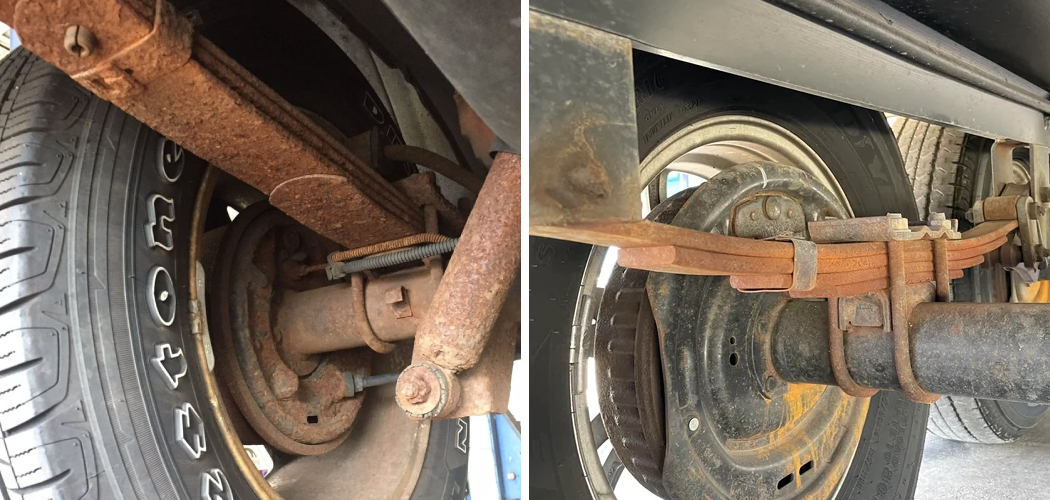Rust and corrosion are the biggest enemies of any vehicle, and Jeep leaf springs are no exception. These important components hold up the weight of your vehicle and keep you stable on rough terrain. However, they are constantly exposed to moisture, dirt, and other corrosive elements that can cause them to rust over time. This not only affects their durability but also compromises your safety while driving.
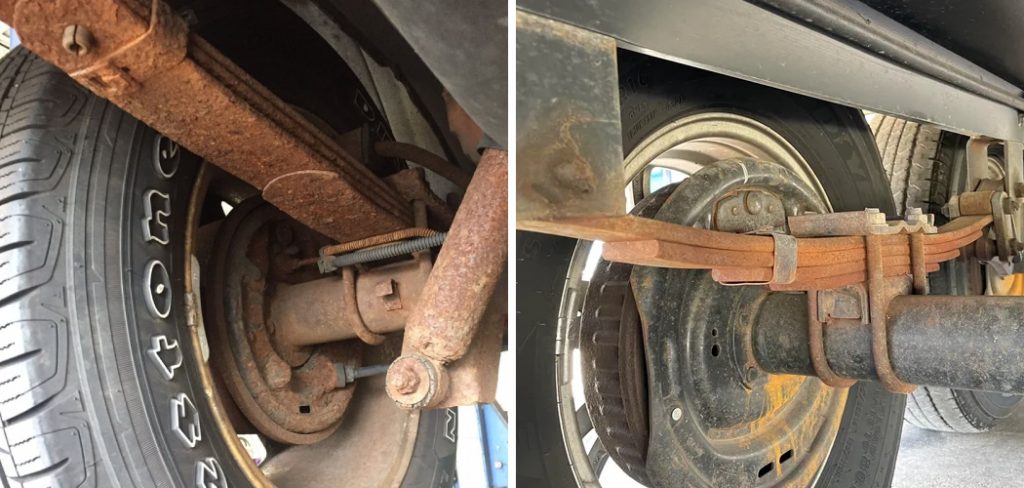
To ensure that your Jeep’s leaf springs last for as long as possible, it is important to take preventive measures against corrosion. In this guide, we will discuss some effective ways how to prevent Jeep leaf spring corrosion and keep your vehicle in top condition and safe for your adventures.
What is Jeeap Leaf Spring Corrosion?
Jeep leaf spring corrosion refers to the gradual deterioration of the metal components in your vehicle’s suspension system. It is a common problem for Jeeps and other off-road vehicles that are constantly exposed to harsh conditions.
The corrosion process begins when moisture, dirt, and other contaminants penetrate the protective layer of paint or coating on the leaf springs. This creates an ideal environment for rust to form, and if left unchecked, it can lead to serious damage that may require expensive repairs or even replacement of the leaf springs.
11 Best Ways on How to Prevent Jeep Leaf Spring Corrosion
1. Regularly Wash Your Jeep:
One of the simplest yet most effective ways to prevent leaf spring corrosion is to wash your Jeep regularly. This will remove any accumulated dirt, salt, or other corrosive substances from the surface of the leaf springs before they have a chance to cause damage.
Make sure to pay special attention to the undercarriage and wheel wells where these contaminants tend to accumulate. This will also help to maintain the protective coating on the leaf springs and prevent it from wearing off.
2. Apply a Protective Coating:
Another important preventive measure is to apply a protective coating on your Jeep’s leaf springs. This can be done using specialized paint or rust inhibitors that are designed for use in harsh environments. Make sure to follow the manufacturer’s instructions carefully and reapply the coating as needed. Applying a protective coating can significantly extend the lifespan of your leaf springs.
3. Keep Your Jeep’s Undercarriage Clean and Dry:
In addition to washing your vehicle, it is important to keep the undercarriage clean and dry as much as possible. This will prevent moisture and dirt from getting trapped in hard-to-reach areas where they can cause corrosion.
Use a high-pressure hose to flush out any debris and make sure to dry the undercarriage thoroughly after washing. If possible, avoid driving through deep mud or water that can cause the undercarriage to become saturated.
4. Check for Damage and Wear:
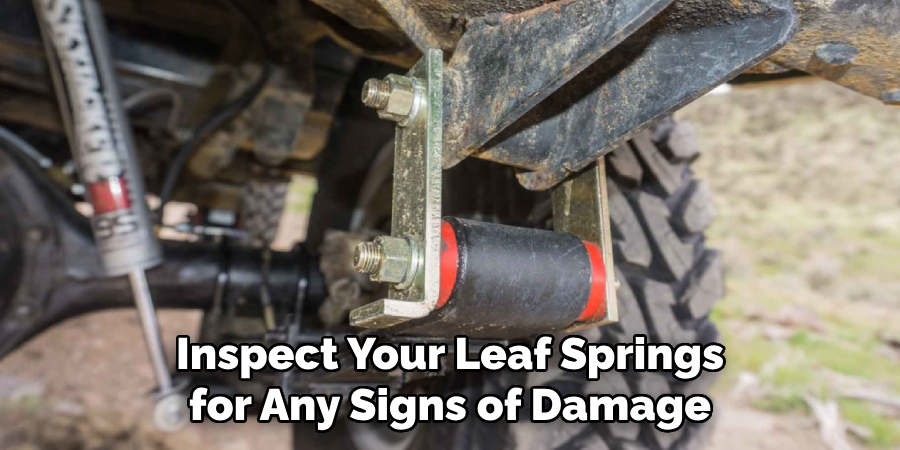
Regularly inspect your leaf springs for any signs of damage or wear. Look for cracks, rust spots, or areas where the coating has worn off. If you notice any issues, address them immediately before they escalate into bigger problems. This will not only prevent corrosion but also ensure that your vehicle is safe to drive. If necessary, have a professional mechanic inspect the leaf springs and make any necessary repairs.
5. Use Mud Flaps:
Mud flaps are another useful accessory that can help prevent corrosion on your Jeep’s leaf springs. They are designed to deflect mud, debris, and other contaminants away from the undercarriage, keeping it clean and dry.
Make sure to choose high-quality mud flaps that are specifically designed for your Jeep’s make and model. Using generic or ill-fitting mud flaps can do more harm than good. This is especially important for off-roading enthusiasts who often encounter muddy or dirty trails.
6. Avoid Driving on Salted Roads:
Salt used to de-ice roads in winter can be extremely corrosive to metal components, including your Jeep’s leaf springs. If possible, avoid driving on salted roads or at least minimize the exposure by taking alternative routes. If you do have to drive on salted roads, make sure to wash your vehicle as soon as possible afterward. Make sure to also rinse the undercarriage thoroughly to remove any salt residue that may have accumulated.
7. Use Rust Inhibitors:
In addition to a protective coating, you can also use rust inhibitors to prevent corrosion on your Jeep’s leaf springs. These products are designed to penetrate the metal and prevent rust from forming.
They are often used in conjunction with a protective coating for maximum effectiveness. Make sure to choose a high-quality rust inhibitor and follow the instructions carefully. Using too much can cause a buildup that may be difficult to remove.
8. Store Your Jeep Properly:
If you are not planning on using your Jeep for an extended period, it is important to store it properly. This includes keeping it in a dry and well-ventilated area where it is protected from moisture and extreme temperatures. If possible, consider using a car cover to provide an extra layer of protection.
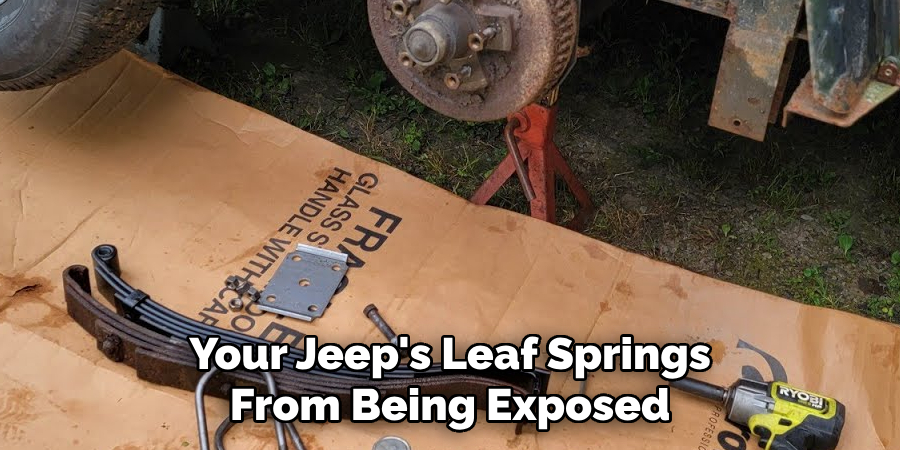
This will prevent your Jeep’s leaf springs from being exposed to the elements and reduce the risk of corrosion. Make sure to also periodically check on your vehicle and address any potential issues before they become a bigger problem.
9. Avoid Driving on Salted Roads:
Salt is commonly used on roads during winter to melt ice and snow, but it can also cause serious damage to your vehicle’s undercarriage. If possible, avoid driving on salted roads or wash your Jeep thoroughly afterward.
Salt can speed up the corrosion process and cause irreparable damage to your leaf springs, so it is best to avoid it as much as possible. This is especially important for those who live in areas with heavy snowfall or coastal regions where saltwater can cause additional corrosion.
10. Invest in Quality Leaf Springs:
When replacing your Jeep’s leaf springs, invest in high-quality ones that are specifically designed for off-road use. These will be more durable and have better protective coatings, making them less susceptible to corrosion.
It may be a larger upfront investment, but it will save you money in the long run by preventing costly repairs or replacements. If you are unsure which leaf springs to choose, consult with a trusted mechanic or do some research online.
11. Be Mindful of Your Driving:
Lastly, be mindful of how you drive your Jeep and the types of terrain you expose it to. Avoid driving through deep mud or water and try not to overload your vehicle beyond its weight capacity. These factors can put extra strain on your leaf springs and increase the risk of corrosion. By being conscious of your driving habits, you can help prevent unnecessary damage to your Jeep’s leaf springs.
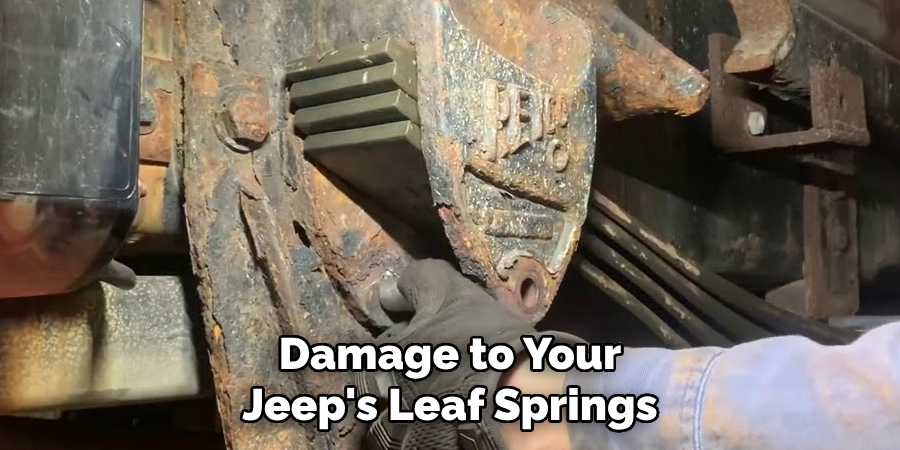
By following these 11 best ways to prevent Jeep leaf spring corrosion, you can ensure that your vehicle remains in top condition for years to come. Regular maintenance and proactive measures are key to preventing corrosion and prolonging the lifespan of your leaf springs.
With these tips in mind, you can confidently take on any off-road adventure without worrying about potential damage to your Jeep’s leaf springs. Happy driving!
Additional Tips and Tricks to Prevent Jeep Leaf Spring Corrosion
1. If you live in an area with high humidity or saltwater exposure, consider applying a rust inhibitor to your leaf springs. This will help prevent moisture from reaching the metal and causing corrosion.
2. Regularly inspect your leaf springs for signs of damage or wear. Look for any cracks, chips, or scratches on the surface of the spring. If you notice any issues, address them promptly to prevent further corrosion.
3. Keep your Jeep clean and well-maintained, especially during winter months when roads are often treated with salt or other de-icing chemicals. Regularly wash off any salt residue from your leaf springs to prevent buildup and potential corrosion.
4. Consider upgrading to stainless steel leaf springs for added protection against rust and corrosion. While they may be more expensive upfront, they can save you money in the long run by reducing the need for frequent replacements.
5. Apply a protective coating or paint to your leaf springs. This can help create an extra barrier between the metal and moisture, preventing corrosion from occurring.
6. Avoid driving through deep puddles or bodies of water that may submerge your leaf springs, as this can accelerate rust and corrosion.
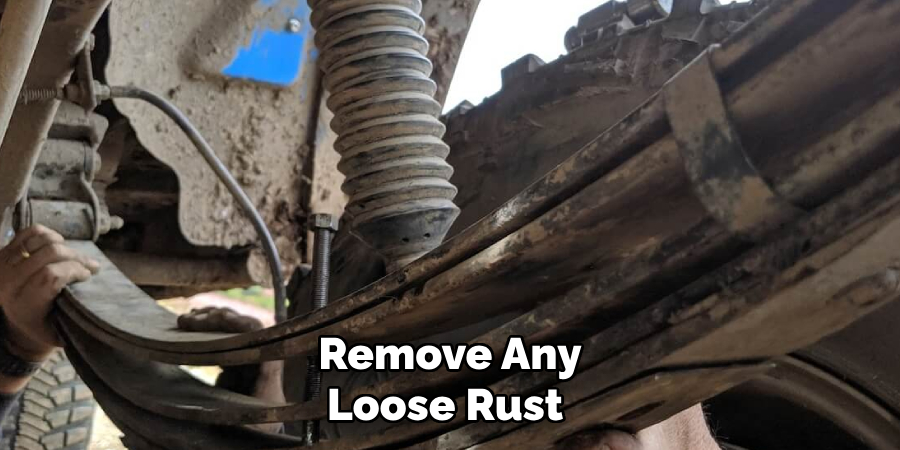
7. If you notice any signs of rust or corrosion on your leaf springs, take action immediately. Use a wire brush to remove any loose rust and apply a rust converter to prevent further damage.
8. Consider investing in a set of leaf spring covers or boots to protect your springs from moisture and debris.
9. Regularly lubricate the hinges and shackles on your leaf springs to prevent them from seizing up and causing damage.
10. When parking your Jeep for extended periods, avoid leaving it in wet areas to prevent moisture from accumulating under the vehicle and potentially causing rust and corrosion.
By following these additional tips and tricks, you can help prolong the life of your Jeep’s leaf springs and prevent costly repairs or replacements. Remember to regularly inspect, clean, and maintain your leaf springs to keep them in top condition and ensure a smooth ride for years to come. Overall, proper care and attention can go a long way in preventing jeep leaf spring corrosion. Happy off-roading!
Things You Should Consider to Prevent Jeep Leaf Spring Corrosion
1. The first thing you should consider is the type of material your leaf springs are made from. Some materials, such as steel, are more prone to corrosion than others like aluminum or composite materials.
2. Regularly inspecting and maintaining your Jeep’s leaf springs is crucial in preventing corrosion. This includes cleaning off any dirt or debris that may be stuck on them, as well as checking for any signs of rust or damage.
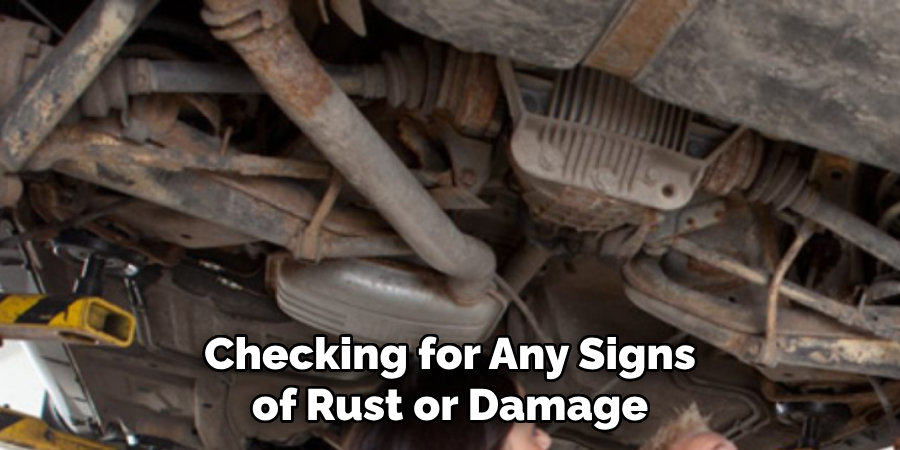
3. Applying a protective coating to your leaf springs can also help prevent corrosion. There are various products available on the market specifically designed for this purpose, such as rust inhibitors or specialized paints.
4. Another important factor to consider is the environment in which you typically drive your Jeep. If you frequently go off-roading in muddy or wet conditions, your leaf springs are more likely to come into contact with corrosive elements and require more frequent maintenance.
5. Additionally, the age of your Jeep can also play a role in leaf spring corrosion. Older models may have worn or damaged protective coatings, making them more susceptible to rust and deterioration.
6. Proper storage of your Jeep can also help prevent leaf spring corrosion. If you live in a particularly humid or salty environment, it may be beneficial to store your Jeep in a garage or covered area to protect it from the elements.
7. Regularly washing your Jeep and removing any road salt or other corrosive substances can also help prevent leaf spring corrosion. Pay extra attention to the undercarriage where dirt and debris tend to accumulate.
8. It’s also important to address any small areas of corrosion on your leaf springs as soon as possible. If left untreated, these small spots can quickly spread and cause significant damage.
9. In addition to preventing corrosion, properly maintaining your leaf springs can also improve their overall performance and longevity. Regularly inspecting and caring for them can help ensure a smoother ride and avoid potential safety hazards.
Following these tips can help prevent Jeep leaf spring corrosion and keep your vehicle running smoothly for years to come. Remember to always prioritize maintenance and address any signs of rust or damage promptly to avoid more extensive repairs in the future.

As a Jeep owner, taking proper care of your leaf springs will not only benefit you and your vehicle but also contribute to the preservation of these iconic off-road vehicles for generations to come. Happy driving!
Frequently Asked Questions
What Causes Jeep Leaf Spring Corrosion?
Several factors can contribute to jeep leaf spring corrosion, such as road salt, moisture, and dirt accumulation. These elements can cause the protective coating on the springs to wear off over time, exposing them to rust and corrosion. Another common reason for corrosion is damage to the protective coating due to off-roading or driving on rough terrain.
How Often Should I Inspect My Jeep Leaf Springs?
It is recommended to inspect your Jeep leaf springs at least every six months. This will allow you to catch any signs of corrosion early on and take the necessary steps to prevent further damage. If you frequently drive in harsh weather conditions or on rough terrain, it may be beneficial to inspect them more often.
What Are the Signs of Jeep Leaf Spring Corrosion?
The most apparent signs of jeep leaf spring corrosion are rust and discoloration on the springs. You may also notice flaking or chipping of the protective coating, which exposes the metal underneath. Additionally, you may experience a bumpy or unstable ride as corrosion weakens the springs’ structural integrity.
What Should I Do If My Jeep Leaf Springs Are Corroded?
If your Jeep leaf springs are corroded, it is essential to take action immediately. Start by cleaning off any dirt or debris from the springs and inspecting them for damage. If the corrosion is minimal, you may be able to repair it with a rust converter or inhibitor. However, if there is significant damage or weakening of the springs, it is best to replace them entirely.
What If I Don’t Address Jeep Leaf Spring Corrosion?

Ignoring Jeep leaf spring corrosion can have significant consequences, including compromising your vehicle’s performance and safety. If left untreated, the springs may eventually break, leading to a loss of control while driving. Additionally, corroded springs can also cause damage to other components of your vehicle’s suspension system.
Can I Prevent Jeep Leaf Spring Corrosion?
While it may not be possible to completely prevent jeep leaf spring corrosion, there are steps you can take to minimize its likelihood. Regularly inspecting and cleaning your springs can help remove any accumulated dirt or salt that could cause corrosion.
Additionally, applying a protective coating or rust inhibitor can also help extend the life of your leaf springs. Finally, avoiding harsh driving conditions and off-roading can also help prevent corrosion.
Conclusion
All in all, knowing how to prevent Jeep leaf spring corrosion is crucial for maintaining the performance and safety of your vehicle. Regularly inspecting and cleaning your springs, avoiding harsh driving conditions, and taking immediate action if corrosion is present can go a long way in preserving the lifespan of your leaf springs.
With proper care, you can ensure that your Jeep leaf springs will continue to provide a smooth and stable ride for many years to come. So, be sure to keep an eye on your leaf springs and address any signs of corrosion promptly. Your vehicle and your wallet will thank you in the long run.
Overall, being proactive in preventing jeep leaf spring corrosion can save you time, and money, and most importantly, keep you safe on the road. Happy driving!

